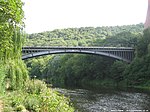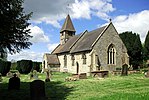Buildwas railway station

Buildwas railway station was an isolated junction railway station on the Wellington to Craven Arms Railway and Severn Valley Railway. Opened on 1 February 1862. Although the station served both the Severn Valley Railway and Wellington to Craven Arms Railway, it was an interchange station in open countryside with no passenger access except by rail.The station had three platforms, with two platforms at a lower level serving the Severn Valley Railway and one at a higher level serving the Wellington to Craven Arms Railway. At its peak, the station had a total of eleven staff, including the station master. Up to 1923 the area was controlled by two signal boxes, the Station signal box controlling the station area and the Junction signal box controlling the junction between the Severn Valley line and the double track line across the Albert Edward Bridge towards Lightmoor Junction. These were replaced with a single signal box approximately midway between its predecessors in 1923. This box was subsequently enlarged to accommodate a frame containing 113 levers on 9 December 1931. The track layout was altered several times during its existence including the additional CEGB sidings opened in 1932.The planned closure of the northern end of the Severn Valley Line including Buildwas station pre-dated the Beeching report. Following closure, the station was demolished to make way for Ironbridge B Power Station. Coal for the power station was offloaded close to the site of the original station until the power station stopped generating electricity in November 2015.The Telford Steam Railway has aspirations to operate to this site, running over the Albert Edward Bridge to a new terminus on or close to the site of Buildwas station.
Excerpt from the Wikipedia article Buildwas railway station (License: CC BY-SA 3.0, Authors, Images).Buildwas railway station
Buildwas Road,
Geographical coordinates (GPS) Address Nearby Places Show on map
Geographical coordinates (GPS)
| Latitude | Longitude |
|---|---|
| N 52.6342 ° | E -2.5167 ° |
Address
Buildwas Junction Station
Buildwas Road
TF8 7BN , Buildwas
England, United Kingdom
Open on Google Maps











